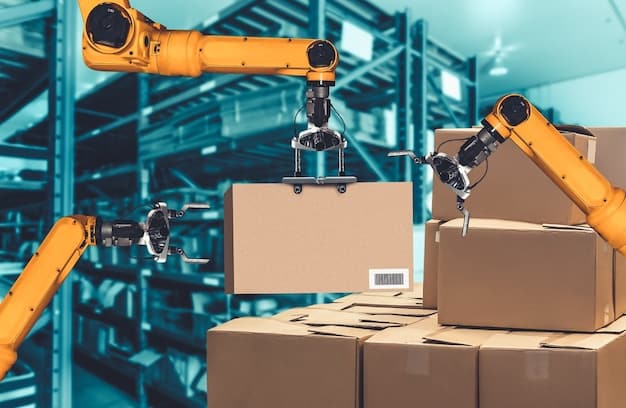AI in Logistics: Optimize Routes & Cut US Transportation Costs

AI in Logistics optimizes delivery routes and reduces transportation costs for US businesses by employing machine learning algorithms to analyze data, predict patterns, and automate processes, ultimately leading to increased efficiency and cost savings.
Is your US-based business struggling with rising transportation costs and inefficient delivery routes? Discover how AI in Logistics: Optimizing Delivery Routes and Reducing Transportation Costs for US Businesses can revolutionize your operations, providing smarter, faster, and more cost-effective solutions.
The Rise of AI in Logistics: A US Perspective
The logistics industry in the United States is undergoing a significant transformation, driven by the integration of artificial intelligence (AI). This technology offers solutions to long-standing challenges, such as optimizing delivery routes, reducing transportation costs, and enhancing overall operational efficiency. US businesses are increasingly adopting AI in Logistics to stay competitive in a rapidly evolving market.
AI’s ability to analyze vast amounts of data and make informed decisions in real time is revolutionizing how goods are transported across the country. From predicting potential delays to dynamically adjusting delivery schedules, AI is empowering logistics companies to operate with greater precision and agility.
Key Applications of AI in Logistics
AI is being applied across various facets of the logistics industry, each contributing to improvements in efficiency and cost-effectiveness.
- Route Optimization: AI algorithms analyze traffic patterns, weather conditions, and delivery schedules to determine the most efficient routes for transportation vehicles.
- Demand Forecasting: Machine learning models predict future demand based on historical data, allowing businesses to optimize inventory levels and reduce warehousing costs.
- Automated Warehousing: AI-powered robots and automated systems streamline warehouse operations, improving speed and accuracy in order fulfillment.
- Predictive Maintenance: AI algorithms monitor the performance of transportation vehicles and equipment, predicting potential maintenance needs and preventing costly breakdowns.
The adoption of AI is not just about improving existing processes; it’s about creating entirely new possibilities for the logistics industry. By leveraging AI, US businesses can unlock unprecedented levels of efficiency, reduce costs, and deliver a superior customer experience.

In conclusion, the rise of AI in logistics represents a paradigm shift for US businesses. The technology’s ability to optimize delivery routes, reduce transportation costs, and enhance overall efficiency is driving its widespread adoption across the industry.
Optimizing Delivery Routes with AI
One of the most impactful applications of AI in logistics is the optimization of delivery routes. Traditional route planning methods often rely on static data and fail to account for real-time changes in traffic, weather, or customer demand. AI-powered route optimization systems, on the other hand, can dynamically adjust routes based on current conditions, ensuring that deliveries are made as efficiently as possible.
These systems use sophisticated algorithms to analyze a variety of data sources, including historical traffic patterns, real-time traffic updates, weather forecasts, and customer delivery preferences. By considering all of these factors, AI can identify the most optimal routes for each delivery vehicle, minimizing travel time and fuel consumption.
Benefits of AI-Powered Route Optimization
Implementing AI-powered route optimization systems can provide a range of benefits for US businesses, including:
- Reduced Fuel Costs: By minimizing travel time and distance, AI can significantly reduce fuel consumption and associated costs.
- Improved Delivery Times: Optimized routes ensure that deliveries are made on time, improving customer satisfaction and loyalty.
- Increased Driver Productivity: Drivers can complete more deliveries per day, increasing their overall productivity.
- Lower Vehicle Maintenance Costs: By reducing wear and tear on vehicles, optimized routes can help lower maintenance costs and extend the lifespan of the fleet.
Moreover, AI in Logistics route optimization systems can also help businesses reduce their carbon footprint by minimizing fuel consumption and emissions. This is becoming increasingly important as companies strive to meet sustainability goals and reduce their environmental impact.
In summary, AI-powered route optimization is a game-changer for the logistics industry. By dynamically adjusting routes based on real-time conditions, these systems can help US businesses reduce costs, improve delivery times, and enhance overall operational efficiency.
Reducing Transportation Costs Through AI
Beyond route optimization, AI can also help US businesses reduce transportation costs through a variety of other applications. These include demand forecasting, predictive maintenance, and automated warehousing, all of which contribute to greater efficiency and cost savings.
Demand forecasting, for example, uses machine learning models to predict future demand based on historical data. This allows businesses to optimize inventory levels, reducing the need for costly warehousing space and minimizing the risk of stockouts. By accurately predicting demand, companies can also avoid overstocking, which can lead to waste and reduced profit margins.

AI Applications for Cost Reduction
Several AI applications significantly contribute to reducing transportation costs for US businesses. Here are some key examples:
- Predictive Maintenance: AI algorithms monitor the performance of transportation vehicles and equipment, predicting potential maintenance needs and preventing costly breakdowns.
- Automated Warehousing: AI-powered robots and automated systems streamline warehouse operations, improving speed and accuracy in order fulfillment.
- Dynamic Pricing: AI algorithms analyze market conditions and adjust pricing in real time, maximizing revenue and optimizing resource allocation.
Furthermore, AI can help businesses optimize their transportation networks by identifying inefficiencies and suggesting improvements. For example, AI can analyze data on delivery routes, vehicle utilization, and fuel consumption to identify opportunities for consolidation and optimization.
In conclusion, AI offers a wide range of tools and techniques for reducing transportation costs. By leveraging these technologies, US businesses can improve efficiency, reduce waste, and enhance their bottom line.
The Impact of AI on Warehousing and Inventory Management
Warehousing and inventory management are critical components of the logistics process, and they are also areas where AI can have a significant impact. Traditional warehousing operations often rely on manual processes, which can be slow, inefficient, and prone to errors. AI-powered warehousing systems, on the other hand, can automate many of these tasks, improving speed, accuracy, and overall efficiency.
One of the key applications of AI in warehousing is automated order fulfillment. AI-powered robots and automated systems can pick, pack, and ship orders with greater speed and accuracy than human workers. This can significantly reduce order fulfillment times and improve customer satisfaction.
Benefits of AI in Warehousing
- Increased Efficiency: AI-powered robots and automated systems can perform tasks faster and more accurately than human workers.
- Reduced Labor Costs: Automation reduces the need for manual labor, lowering labor costs and improving profitability.
- Improved Accuracy: AI systems reduce errors in order fulfillment and inventory management, improving customer satisfaction.
- Optimized Inventory Management: AI algorithms can predict future demand and optimize inventory levels, reducing warehousing costs and minimizing the risk of stockouts.
The use of AI in inventory management also enables real-time tracking and visibility. This allows businesses to monitor inventory levels, track shipments, and proactively address potential issues.
In short, AI is transforming warehousing and inventory management, enabling US businesses to operate more efficiently, reduce costs, and improve customer satisfaction.
Challenges and Considerations for AI Adoption
While AI offers significant potential for improving logistics operations, there are also challenges and considerations that US businesses must address when adopting the technology. One of the biggest challenges is the cost of implementation. AI systems can be expensive to purchase, install, and maintain, especially for small and medium-sized businesses.
Additionally, there is a need for skilled personnel to manage and maintain AI systems. This may require businesses to invest in training programs or hire new employees with expertise in AI and machine learning.
Key Considerations for AI Implementation
- Data Privacy and Security: AI systems collect and analyze vast amounts of data, raising concerns about data privacy and security. Businesses must implement robust security measures to protect sensitive data from unauthorized access.
- Integration with Existing Systems: Integrating AI systems with existing logistics infrastructure can be complex and challenging. Businesses must carefully plan the integration process to ensure compatibility and minimize disruption.
- Ethical Considerations: The use of AI in logistics raises ethical considerations, such as the potential for job displacement and the need to ensure fairness and transparency in decision-making.
Despite these challenges, the benefits of AI adoption often outweigh the costs. By carefully planning and addressing potential challenges, US businesses can successfully implement AI and reap the rewards of improved efficiency, reduced costs, and enhanced customer satisfaction.
In conclusion, adopting AI in logistics requires careful consideration of potential challenges. However, the benefits of AI adoption, such as improved efficiency and reduced costs, often outweigh these challenges.
Future Trends in AI for Logistics in the US
The field of AI is constantly evolving, and there are several emerging trends that are likely to shape the future of logistics in the US. One of the most promising trends is the development of more sophisticated AI algorithms that can handle even more complex and dynamic logistics scenarios.
For example, researchers are working on developing AI systems that can better predict and respond to disruptions in the supply chain, such as natural disasters or geopolitical events. These systems would be able to dynamically adjust delivery routes, reroute shipments, and optimize inventory levels to minimize the impact of disruptions.
Emerging AI Trends in Logistics
- Autonomous Vehicles: Self-driving trucks and delivery drones have the potential to revolutionize transportation, reducing labor costs and improving delivery times.
- AI-Powered Chatbots: AI chatbots can provide instant customer support, answering questions, resolving issues, and improving customer satisfaction.
- Predictive Analytics: Advanced analytics can help businesses anticipate future demand, optimize inventory levels, and make better decisions about pricing and resource allocation.
As AI technology continues to advance, its applications in logistics will become even more sophisticated and widespread. US businesses that embrace these trends will be well-positioned to thrive in the future.
In summary, the future of AI in logistics is bright, with several emerging trends poised to transform the industry. US businesses that embrace these trends will be well-positioned for success.
| Key Point | Brief Description |
|---|---|
| 🚚 Route Optimization | AI optimizes delivery routes, reducing fuel and improving delivery times. |
| 📊 Demand Forecasting | AI predicts demand, optimizing inventory and reducing warehousing costs. |
| 🤖 Automated Warehousing | AI automates warehouse tasks, improving order fulfillment speed and accuracy. |
| 🛠️ Predictive Maintenance | AI predicts equipment maintenance needs, preventing costly breakdowns. |
FAQ
▼
AI in Logistics refers to the use of artificial intelligence technologies to optimize and automate various processes within the logistics and supply chain industry, such as route planning, inventory management, and demand forecasting.
▼
AI algorithms analyze real-time traffic data, weather conditions, and delivery schedules to determine the most efficient routes, minimizing travel time, fuel consumption, and overall transportation costs for US businesses.
▼
AI-powered demand forecasting enables businesses to predict future demand based on historical data, optimizing inventory levels, reducing warehousing costs, and minimizing the risk of stockouts or overstocking.
▼
US businesses adopting AI in Logistics may encounter challenges such as high implementation costs, the need for skilled personnel, data privacy and security concerns, and the complexity of integrating AI systems with existing infrastructure.
▼
Future trends in AI in Logistics include the development of more sophisticated algorithms, autonomous vehicles, AI chatbots for customer support, and advanced predictive analytics for better decision making in US businesses.
Conclusion
In conclusion, AI in Logistics is revolutionizing the way US businesses manage their supply chains and transportation operations, driving greater efficiency, reducing costs, and enhancing customer satisfaction. By embracing AI technologies, companies can optimize delivery routes, improve inventory management, and stay ahead in a rapidly evolving market.





